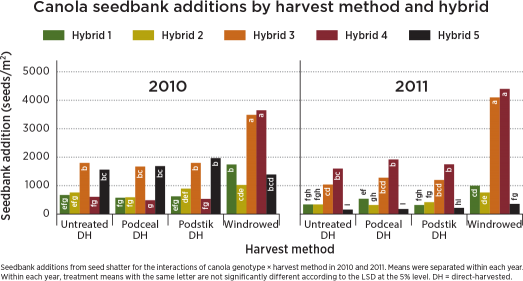Reduce losses while combining
Key practice: Ground speed and mechanical adjustments to the combine can reduce harvest losses and increase yields. For growers who want to try straight combining, start with one field with uniform maturity and high yield potential.
Key research: Gulden, R.H., University of Manitoba, et al. “Evaluation of Harvest Losses and Their Causes in Canola Across Western Canada.” Canola Digest Science Edition (2013).
Haile, T.A., University of Saskatchewan, et al. “Canola Genotypes and Harvest Methods Affect Seedbank Addition.” Agronomy Journal (2014).
Holzapfel, C., Indian Head Agriculture Research Foundation. “Evaluating the Effects of Glyphosate and Pod Sealants on the Yield of Straight-Combined Canola on a Large Field-Scale.” Canola Agronomic Research Program (CARP) project (2011).
Holzapfel, C., Indian Head Agriculture Research Foundation. “Evaluating the Effectiveness of Pod Sealants for Reducing Shattering Losses in Several Cultivars of Direct-Combined Canola.” CARP project (2010).
Improved genetics, larger farms and the yield benefits realized in fields harvested at (at least) 60 percent seed colour change (SCC) have made straight combining an attractive — and realistic — alternative to swathing. There is good reason for this consideration, too: reduced time, cost and equipment wear, along with the potential increases in seed size, yield and oil content associated with this harvest method. However, the increased risk can be a deterrent.
Determining which method is most appropriate requires the consideration of several factors, which may vary in importance according to the growing conditions in an area. A two-year study: “Canola Genotypes and Harvest Methods Affect Seedbank Addition,”
by Teketel Haile et al (2014), determined that swathing resulted in significantly higher seed shatter, and consequently greater seed loss than straight combining. In addition to this yield loss, the seeds contribute to volunteers that will have to be managed the following year, requiring more time, machinery use and cost.
Major pre-harvest losses come from pod drop and pod shattering. Commercial pod sealant products may seem to provide a quick way to prevent these losses, but Haile tested two of these products and found that neither had a significant impact on seed loss in canola. In fact, in this study, the pod sealant (straight combined) treatments added a significantly greater number of seeds to the seedbank than the swathed treatment. The straight combined sites in another Haile et al study (2014) produced seeds with significantly higher 1,000-seed weight, which, along with the reduced cost of running over the field twice, suggests that straight combining can be attractive for reasons other than just reduced harvest losses.
Reducing harvest losses, whether picking up a swath or straight combining, can be achieved with slower combine speeds and through variety selection, as Gulden found in his Growing Forward study: “Evaluation of Harvest Losses and Their Causes in Canola Across Western Canada.” Combine method, time of day of swathing, and combine type and manufacturer were not shown to have significant impacts on harvest losses.
Alternatively, Chris Holzapfel’s 2011 study of combine headers found the draper header to be better than a rigid type or an extended header with the knife out front of the reel. The Ontario Canola Growers Association also ran a study in 2012 to compare shatter loss and yield differences between three straight cut headers. It found that a modified 30-foot John Deere 930 header with the flex pan removed and replaced with a solid pan with an 18″ table extension had the lowest seed loss.
Wheatland Conservation Area at Swift Current, SK found some evidence that specialty headers with the knife
out front of the reel will reduce shatter losses, but concluded that more work is necessary in a wider range of Prairie conditions. Prairie Agricultural Machinery Institute (PAMI) has just begun another comparison.
Testing combine loss and making several minor adjustments can save big losses. For tips on how to check harvest losses, go to www.canolawatch.org and search for the article “Reduce costly harvest losses — tips.”
Aside from all the aspects growers can control, Holzapfel highlighted some additional aspects of straight combining. Timing of desiccant applications are critical to the resulting green seed counts in straight combining operations, and if desiccants aren’t applied aerially, driving over a crop can lead to wheel tracks reducing yield by two to five percent. Therefore, Holzapfel suggested selecting a variety suitable for this harvest method. One that is high-yielding and relatively resistant to shattering is ideal. Paying extra attention to the maturity level of the crop in order to avoid harvest delays on these fields is also beneficial.
For more on the risks and benefits of straight combining versus swathing, see the article “Straight combining: Risk or reward?” in the September 2013 edition of Canola Digest. Go to www.canolacouncil.org and search for this title.





